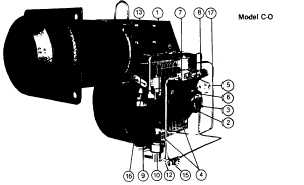TM 5-3895-374-24-2
MECHANICAL OPERATION: This Low-High-Off system uses a
two-stage Oil Pump (2) with an internal bypass Oil Nozzle (14)
(see note 1, page 20) in conjunction with Movable Air Dampers (4)
to provide a low fire start and a high fire run sequence. A direct
spark oil ignition system will normally be supplied at firing rates up
to 45 GPH, with a spark ignited gas pilot’ to ignite the main oil
flame above that point. Certain insurance company codes will
require the gas pilot system on lower input sizes. Nozzle supply
pressure is set by adjusting the Oil Pump Pressure Regulator 'A”
Allen wrench fitting (3). Turn clockwise to increase the pressure
and counter-clockwise to decrease the pressure to the Nozzle.
Nozzle supply pressure is taken at the plugged Pump Nozzle
Pressure Gauge Port (6). Nozzle supply pressure will normally be
approximately 300 PSI at both high and low firing rates. Flow rate
pressure for both high and low fire is taken at Bypass Pressure
Gauge Tee (15). Low fire pressures are set by adjusting the low
fire Regulating Valve (8). Turning the low fire Regulating Valve
adjustment nut clockwise will increase the pressure at the Bypass
Pressure Test Tee Gauge (increasing the low fire input) and
counter clockwise will reduce the pressure at the gauge
(decreasing the low fire input). Low fire pressure will normally be
in the 60 to 100 PSI range and at high fire in the 180 to 225 PSI
range, but both pressures will vary according to the specific nozzle
being used, as well as job conditions. At light off, the Main Oil
Solenoid Valve (1) is energized, allowing fuel to flow to the Nozzle.
At the same instant a portion of the oil bypasses the Nozzle
through the adjustable low fire regulating valve, reducing the
pressure at the Nozzle as required for low fire rates. When the low
fire flame is proven by the flame detector', the Return Oil Solenoid
Valve (7) is de-energized, putting full high fire pump pressure on
the Nozzle. Simultaneously, the Three-Way Solenoid Valve (10) is
energized, allowing oil into the Hydraulic Cylinder (9) which
mechanically drives the Air Damper Arm (13) to the high fire
position. The burner operates at full high fire until the system
demand is satisfied. Refer to page 30, Table 8 or page 31, Table 9
to determine nozzle return flow pressure and flow rates. This
depiction shows the Air Dampers and Hydraulic Cylinder at the low
fire light off position.
The Low-High-Low system is identical to the Low-High-Off system,
except that an additional pressure or temperature controller is
added to the system, which at a selected preset point will
electrically switch the burner
to either the high or low fire position. When the burner is running
at high fire and the controller calls for low fire, the normally closed
Oil Solenoid Return Valve (7) (closed at high fire) is energized,
reducing nozzle pressure to the low fire rate. Simultaneously, the
Three-Way Solenoid Valve (10) is de-energized, allowing oil to
flow out of the Hydraulic Cylinder (9) back to the Pump and driving
the Air Dampers (4) to the low fire position. Responding to load
conditions, the burner can alternate indefinitely between the low
and high fire positions without shutting down. When system load
demand is satisfied, all fuel valves are de-energized and the Air
Dampers are placed in the light off position in preparation for the
next firing cycle. The opening distance of the Air Dampers is
controlled by positioning the Air Damper Drive Arm (13) relative to
the Acorn Nut (16) mounted on the end of the Hydraulic Cylinder
piston rod. The maximum travel is with the Damper Drive Arm
positioned to be in contact with the hydraulic oil cylinder Acorn Nut
at all times. If less travel is desired set the Air Damper Drive Arm
to allow a gap between it and the Acorn Nut. (Depending on Air
Damper positioning, it may be necessary to loosen its set screws
to attain proper Air Damper opening distance.) The wider the gap
(when the burner is off), the less the overall travel when going to
the high fire position. When setting the Drive Arm position, relative
to the Acorn Nut, make certain that the Air Dampers' travel is
correct for proper combustion at all firing positions and that there is
no binding of the Linkage or Dampers. Make certain the cast iron
Linkage Return Weight (5) is secure on its Air Damper Arm (17).
* Not shown in this depiction. See page 4, Fig. 2
Note 1
The system depicted in Fig. 23 uses a
Webster Model 22R oil pump. II your
system uses a Suntec H model pump, the
sequence
of
operation
and
the
oil
components would be identical to the
Webster
22R
system.
For
additional
information on your specific system refer to
the oil piping diagram and the oil pump
manufacturer’s bulletin supplied with the
burner.
Note 2
Component operational
sequencing
will
vary with the specific Flame Safeguard
Control being used. Refer to the specific
Flame Safeguard Control bulletin supplied
with the burner for complete Information.
(page 3-969)



